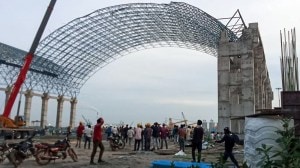Now, Kalam targets space with Hyperplane
PUNE, May 24: Senior scientists call it Defence Research and Development Organisation (DRDO) chief and scientific advisor to the Union Defen...

PUNE, May 24: Senior scientists call it Defence Research and Development Organisation (DRDO) chief and scientific advisor to the Union Defence Minister A P J Abdul Kalam’s dream project. The "Single-Stage-to-Orbit Launch Vehicle" or the "Hyperplane" — as the new concept for flight to orbit is called — will soon become a reality.
According to scientists who prefer to call this India’s "big-time" project, the arrival of Hyperplane would not only give world space technology a strategic choice, but also suggests the feasibility of increasing the payload capacities and decreasing the unit payload cost. Until now, in the absence of a credible cost-effective design, almost all nations of the world have chosen the existing path of rocket launchers, while being fully aware of their performance limitations.
A conceptual study has already been completed for this ambitious project. Scientists say foreign agencies have showed interest in the programme but refuse to divulge details about the extent of theirinvolvement in the project which is expected to involve the use of composite material.
The Hyperplane can be put into orbit at around 200 kms above the earth and could fire missiles with smaller propulsion systems onto the target without being intercepted by the enemy. This can be achieved because the anti-ballistic role of the system cannot be perceived by the enemy target. A single Hyperplane can fire around five to ten continental missiles.
More significantly, at a later stage, the vehicle is expected to be used for converting solar energy into electricity, thus taking care of energy needs in the future. This could be achieved if solar panels are fitted onto the plane to convert solar energy into electricity, say scientists but they add that India does not have the level of superconductivity required to achieve this goal.
The Hyperplane is based on the concept of in-flight liquefaction of oxygen, unfolding an altogether new principle in flight performance. The highlight of the model, according toscientists, is that, it first computes the liquid oxygen required for the rocket phase with zero air collection and then literally computes the subsequent requirement after hitting the target.
In sharp contrast to a multistage vertical launch rocket system, the flight path of a Single-Stage-To-Orbit Vehicle is typically a hybrid between the aircraft path and that of a rocket. The flight corridor is so designed to take advantage of the lift generating capabilities of an aircraft, with the added benefit of a rocket path which exploits the centrifugal forces, say scientists.
A patent for the proposed air-liquefaction concept and design has been sought. At present, approximately 125 tonnes of liquid oxygen is used in the final rocket phase and the entire quantity is assumed to be collected from the atmosphere during the cruise phase. The cruise flight time is about 1,400 seconds which means an average collection rate of approximately 90 g per second.
The Hyperplane will employ two aspects of air-breathing– direct air-breathing propulsion as well as air collection in flight. In addition, pre-programmed altitude control has been proposed till the levelling off phase of the flight to control altitude and velocity of the cruise phase.
Senior scientists point out that the Hyperplane unit cost would be one-thirtieth the cost of a rocket launcher. Significantly, two to five Hyperplane flights are sufficient to break even with rocket launchers, apart from assuring a fully reusable system, thus establishing the economy of getting into such a venture.
Both the United Kingdom and the US are reported to be working on aerospace places called "Hotol", "X-30" or NASP. The basic conceptual difference between these and the Hyperplane lie in the air breathing propulsion technology and in-flight air collection. "Hotol" is rocket-propelled and incorporates air collection to a limited extent, a scientist said, adding that NASP takes air breathing engines but does not consider air collection at all.
The Hyperplane, however,incorporates both the air-breathing engines and air-collection tech in design thus offering a choice before the world to move to an era of high payload, low-cost capability in space.



- 01
- 02
- 03
- 04
- 05




























